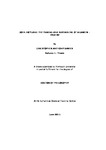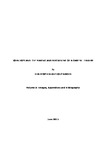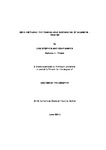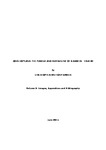JOHN HOYLAND: THE MAKING AND SUSTAINING OF A CAREER - 1960-82
| dc.contributor.supervisor | Smiles, Sam | |
| dc.contributor.author | Davies, Christopher Anthony | |
| dc.contributor.other | Faculty of Arts, Humanities and Business | en_US |
| dc.date.accessioned | 2016-08-01T08:52:39Z | |
| dc.date.available | 2016-08-01T08:52:39Z | |
| dc.date.issued | 2015 | |
| dc.identifier | 10207021 | en_US |
| dc.identifier.uri | http://hdl.handle.net/10026.1/5139 | |
| dc.description | Full version unavailable due to 3rd party copyright restrictions. | |
| dc.description.abstract |
The thesis explores the making and sustaining of the career of the English abstract artist, John Hoyland from his inclusion in the seminal Situation exhibition of 1960 to his winning the John Moores First (Purchase Prize) in 1982. It investigates the institutional and critical contexts that supported Hoyland’s rise to prominence in the 1960s and situates him within the art world of the time: its galleries, exhibitions, advocates, dealers, critics, patrons and collectors (public and private). It notes the improvements to the art infrastructure in the United Kingdom and assesses whether these improvements had any impact on Hoyland’s career. Careful analytical attention is paid to the work of John Hoyland and how his work was presented to numerous audiences and critically received. Hoyland’s career is considered in relation to the changes in art practice both in the United Kingdom and the United States during these two decades, and the challenges that these changes in practice and fashion through up, The thesis examines John Hoyland’s early career with these critical and institutional contexts in mind. It considers the challenges he faced throughout the 1970s to sustain a professional career and offers reasons to explain why his trajectory towards professional success was neither smooth nor consistent. The thesis explores the correlation between art production, art markets, critical reception and acclaim, and commercial success. The fundamental question that this thesis seeks to answer is whether whatever recognition Hoyland’s work received was solely because of its quality or whether there is an element of Hoyland being buoyed up by the system and promoted with more enthusiasm than was merited - as American critics suggested – and thus being to some extent a product of these institutional forces. The mapping and analysis of John Hoyland’s early career contributes to similar inquiries concerning how careers are made and sustained in the visual arts. The thesis works with the established models used to explore this process and offers some adaptations of them. | en_US |
| dc.language.iso | en | en_US |
| dc.publisher | Plymouth University | en_US |
| dc.subject | John Hoyland | en_US |
| dc.title | JOHN HOYLAND: THE MAKING AND SUSTAINING OF A CAREER - 1960-82 | en_US |
| dc.type | Thesis | |
| plymouth.version | Edited version | en_US |
| dc.identifier.doi | http://dx.doi.org/10.24382/1463 |
Files in this item
This item appears in the following Collection(s)
-
01 Research Theses Main Collection
Research Theses Main





